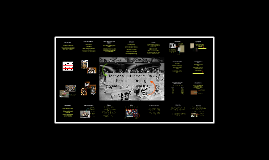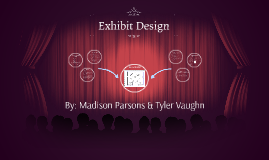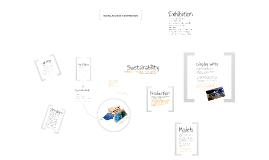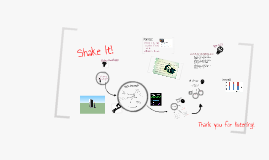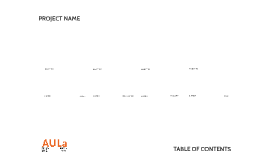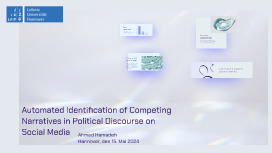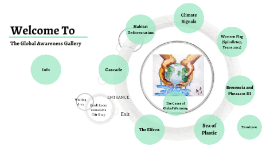Exhibit Design
Transcript: Welcome To The Global Awareness Gallery ENTRANCE Waiting Area Kiosk Room Donations Gift Shop Exit Welcome! On behalf of the Global Climate Awareness Group, I think you for your attendance. This gallery is filled with photographs, digital images, and paintings that represent out changing climate and the impact climate change has on our planet. Info While in the gallery, your group will only have 10 minutes to view the art to create a sense of urgency regarding climate change. All of the works are aviable to view at the kiosks outside the gallery if you miss one or want more time with a piece. Please note that some of images are very emotionally charged. Fun Facts! This gallery is 100% powered by renewable solar and wind energy The open, circular format represents the world we live in and how we are all connected. While admission to this gallery is free of cost, we hope that you find ways to invest your funds into bettering our planet. At the end of the gallery tour, there are kiosks where you can learn more about climate groups that you can donate to, and you will also find our gift shop with products to reduce single-use plastics. 40% of proceeds from the gift shop will go towards climate active groups. We want to show you that you can make a difference. All artists depicted in this group are also climate activists. Cascade, 2015 Cascade Cascade Alexis Rockman 2015 Oil and Alkyod on Wood Gand Rapids Art museum Cascade Alexis Rockman 2015 Alexis Rockman is a climate change activist who had been working in 1994 on spreading the word of our changing world through art. "Cascade" is part of a collection that explores the history and future of America's Great Lakes. Rockman hopes that we can rally as a species and avoid disaster, and his art contains the fear he feels on what would happen to our Earth if we lost the Great Lakes. Rockman uses his artwork to allow people to visually experience the change Rockman depicts in a more impactful way then just reading it in the news. By using bright, vibrant oil colors and realistic scenes, Rockman draws the eye from the left side of the painting to the right, showing the habitats and the animals and then what they are heading towards. The work is striking and ominous, but the live animals depicted on the left-hand scene give us hope and something to want to save. "Cascade" is part of Rockman's "Great Lakes Cycle" and can be found in Grand Rapids Art Museum. Consider donating to The Great Lakes Commission to support conservation How You Can Help. Look at the left-side of this painting? See the caribou, the fish, the migrating ducks? Look at the melting ice behind them with their cool colors reflecting a feeling of calm. Can you spot the snake in the water? This painting shows us the beauty of the Great Lakes, a place that hold 20% of the world's freshwater reserves. Now, look over to the right side of the painting. The colors are warmer where, brighter, almost showing the world at sunset on its last day. Do you see the waste in the water? The colorful sheen of oil in the background? Look at the logging boats and the fishing lines. This is the disaster pending, and the animals on the left are swimming right towards it. "I made art partly to cope with what I was witnessing and to support a campaign for conservation. I believed that if one could render moments of extinction, genocide, population explosion and political discord visible, then we might learn to confront and change the conditions leading to civilization’s collapse" Rockman says, expressing feelings we have all felt. Take one last look at this painting and remember how beautiful the left is and how horrifying the right looks. Deforestation Habitat Deforestation Deforestation Jill Pelto Watercolor Deforestation "Deforestation" by Jill Pelto is part of her collection "Habitat Degradation" which comments on the negative impact humans have had on ecosystems across the globe. While also being a scientist, Pelto travels around the world, collecting data on receding ice sheets and dabbles in art on the side. She hopes to show the impact people have on the planet by painting about issues to spread awareness. Pelto's collection, "Habitat Degradation" includes melting ice, massive wildfires, overfishing, ocean pollution, and mining. "My love of nature drives me to creatively communicate information about environmental issues with a broad audience" Pelto says on her website, "I see nature as a work of art, and the origin of my observational skills." While her pieces are not in any museums, Pelto does display her art at functions to help raise awareness. Her background as a scientist fuels her painting, and her degrees in Master of Science and her bachelors degrees in Studio Art and Earth Science further build her credibility. Check out more of Jill Pelto's work: http://www.jillpelto.com/gallery Consider donating to "Amazon Watch" or "Amazon Conservation Association" How You Can Help. Look at the way the tiger is separate from






